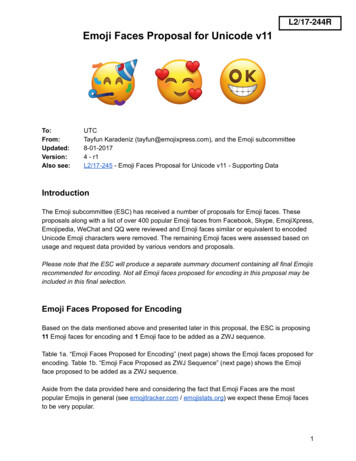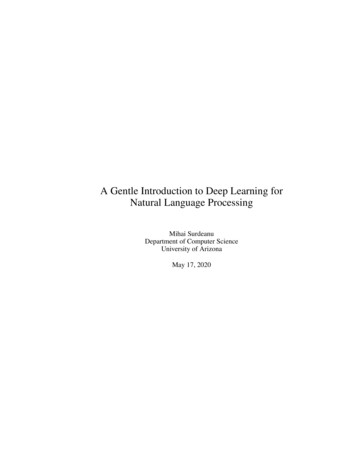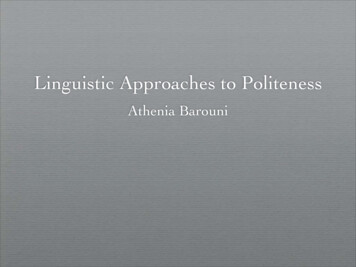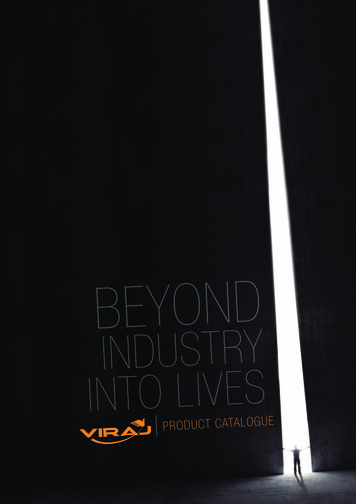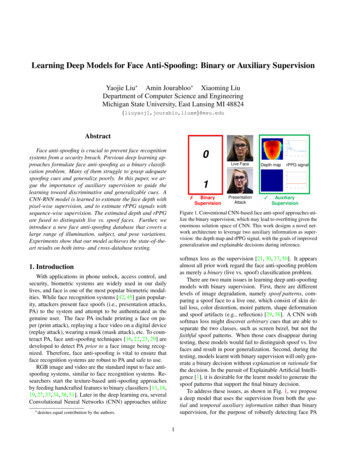
Transcription
Learning Deep Models for Face Anti-Spoofing: Binary or Auxiliary SupervisionYaojie Liu Amin Jourabloo Xiaoming LiuDepartment of Computer Science and EngineeringMichigan State University, East Lansing MI 48824{liuyaoj1,jourablo,liuxm}@msu.eduAbstractFace anti-spoofing is crucial to prevent face recognitionsystems from a security breach. Previous deep learning approaches formulate face anti-spoofing as a binary classification problem. Many of them struggle to grasp adequatespoofing cues and generalize poorly. In this paper, we argue the importance of auxiliary supervision to guide thelearning toward discriminative and generalizable cues. ACNN-RNN model is learned to estimate the face depth withpixel-wise supervision, and to estimate rPPG signals withsequence-wise supervision. The estimated depth and rPPGare fused to distinguish live vs. spoof faces. Further, weintroduce a new face anti-spoofing database that covers alarge range of illumination, subject, and pose variations.Experiments show that our model achieves the state-of-theart results on both intra- and cross-database testing.0Live FacerPPG signal1 BinarySupervisionPresentationAttack AuxiliarySupervisionFigure 1. Conventional CNN-based face anti-spoof approaches utilize the binary supervision, which may lead to overfitting given theenormous solution space of CNN. This work designs a novel network architecture to leverage two auxiliary information as supervision: the depth map and rPPG signal, with the goals of improvedgeneralization and explainable decisions during inference.softmax loss as the supervision [21, 30, 37, 50]. It appearsalmost all prior work regard the face anti-spoofing problemas merely a binary (live vs. spoof) classification problem.There are two main issues in learning deep anti-spoofingmodels with binary supervision. First, there are differentlevels of image degradation, namely spoof patterns, comparing a spoof face to a live one, which consist of skin detail loss, color distortion, moiré pattern, shape deformationand spoof artifacts (e.g., reflection) [29, 38]. A CNN withsoftmax loss might discover arbitrary cues that are able toseparate the two classes, such as screen bezel, but not thefaithful spoof patterns. When those cues disappear duringtesting, these models would fail to distinguish spoof vs. livefaces and result in poor generalization. Second, during thetesting, models learnt with binary supervision will only generate a binary decision without explanation or rationale forthe decision. In the pursuit of Explainable Artificial Intelligence [1], it is desirable for the learnt model to generate thespoof patterns that support the final binary decision.To address these issues, as shown in Fig. 1, we proposea deep model that uses the supervision from both the spatial and temporal auxiliary information rather than binarysupervision, for the purpose of robustly detecting face PA1. IntroductionWith applications in phone unlock, access control, andsecurity, biometric systems are widely used in our dailylives, and face is one of the most popular biometric modalities. While face recognition systems [42, 45] gain popularity, attackers present face spoofs (i.e., presentation attacks,PA) to the system and attempt to be authenticated as thegenuine user. The face PA include printing a face on paper (print attack), replaying a face video on a digital device(replay attack), wearing a mask (mask attack), etc. To counteract PA, face anti-spoofing techniques [16, 22, 23, 29] aredeveloped to detect PA prior to a face image being recognized. Therefore, face anti-spoofing is vital to ensure thatface recognition systems are robust to PA and safe to use.RGB image and video are the standard input to face antispoofing systems, similar to face recognition systems. Researchers start the texture-based anti-spoofing approachesby feeding handcrafted features to binary classifiers [13, 18,19, 27, 33, 34, 38, 51]. Later in the deep learning era, severalConvolutional Neural Networks (CNN) approaches utilize denotesDepth mapequal contribution by the authors.1
from a face video. These auxiliary information are acquiredbased on our domain knowledge about the key differencesbetween live and spoof faces, which include two perspectives: spatial and temporal. From the spatial perspective,it is known that live faces have face-like depth, e.g., thenose is closer to the camera than the cheek in frontal-viewfaces, while faces in print or replay attacks have flat or planar depth, e.g., all pixels on the image of a paper have thesame depth to the camera. Hence, depth can be utilizedas auxiliary information to supervise both live and spooffaces. From the temporal perspective, it was shown that thenormal rPPG signals (i.e., heart pulse signal) are detectablefrom live, but not spoof, face videos [31, 35]. Therefore,we provide different rPPG signals as auxiliary supervision,which guides the network to learn from live or spoof facevideos respectively. To enable both supervisions, we designa network architecture with a short-cut connection to capture different scales and a novel non-rigid registration layerto handle the motion and pose change for rPPG estimation.Furthermore, similar to many vision problems, dataplays a significant role in training the anti-spoofing models. As we know, camera/screen quality is a critical factorto the quality of spoof faces. Existing face anti-spoofingdatabases, such as NUAA [44], CASIA [52], ReplayAttack [17], and MSU-MFSD [47], were collected 3 5years ago. Given the fast advance of consumer electronics, the types of equipment (e.g., cameras and spoofingmediums) used in those data collection are outdated compared to the ones nowadays, regarding the resolution andimaging quality. More recent MSU-USSA [38] and OULUdatabases [14] have subjects with fewer variations in poses,illuminations, expressions (PIE). The lack of necessaryvariations would make it hard to learn an effective model.Given the clear need for more advanced databases, we collect a face anti-spoofing database, named Spoof in the WildDatabase (SiW). SiW database consists of 165 subjects, 6spoofing mediums, and 4 sessions covering variations suchas PIE, distance-to-camera, etc. SiW covers much largervariations than previous databases, as detailed in Tab. 1 andSec. 4. The main contributions of this work include: We propose to leverage novel auxiliary information(i.e., depth map and rPPG) to supervise the CNN learningfor improved generalization. We propose a novel CNN-RNN architecture for endto-end learning the depth map and rPPG signal. We release a new database that contains variations ofPIE, and other practical factors. We achieve the state-ofthe-art performance for face anti-spoofing.2. Prior WorkWe review the prior face anti-spoofing works in threegroups: texture-based methods, temporal-based methods,and remote photoplethysmography methods.Texture-based Methods Since most face recognition systems adopt only RGB cameras, using texture informationhas been a natural approach to tackling face anti-spoofing.Many prior works utilize hand-crafted features, such asLBP [18, 19, 33], HoG [27, 51], SIFT [38] and SURF [13],and adopt traditional classifiers such as SVM and LDA.To overcome the influence of illumination variation, theyseek solutions in a different input domain, such as HSV andYCbCr color space [11, 12], and Fourier spectrum [29].As deep learning has proven to be effective in many computer vision problems, there are many recent attempts of using CNN-based features or CNNs in face anti-spoofing [21,30, 37, 50]. Most of the work treats face anti-spoofing as asimple binary classification problem by applying the softmax loss. For example, [30, 37] use CNN as feature extractor and fine-tune from ImageNet-pretrained CaffeNet andVGG-face. The work of [21, 30] feed different designs ofthe face images into CNN, such as multi-scale faces andhand-crafted features, and directly classify live vs. spoof.One prior work that shares the similarity with ours is [5],where Atoum et al. propose a two-steam CNN-based antispoofing method using texture and depth. We advance [5] ina number of aspects, including fusion with temporal supervision (i.e., rPPG), finer architecture design, novel non-rigidregistration layer, and comprehensive experimental support.Temporal-based Methods One of the earliest solutions forface anti-spoofing is based on temporal cues such as eyeblinking [36,37]. Methods such as [26,43] track the motionof mouth and lip to detect the face liveness. While thesemethods are effective to typical paper attacks, they becomevulnerable when attackers present a replay attack or a paperattack with eye/mouth portion being cut.There are also methods relying on more general temporal features, instead of the specific facial motion. The mostcommon approach is frame concatenation. Many handcrafted feature-based methods may improve intra-databasetesting performance by simply concatenating the features ofconsecutive frames to train the classifiers [11,18,28]. Additionally, there are some works proposing temporal-specificfeatures, e.g., Haralick features [4], motion mag [7], and optical flow [6]. In the deep learning era, Feng et al. feed theoptical flow map and Shearlet image feature to CNN [21].In [49], Xu et al. propose an LSTM-CNN architecture toutilize temporal information for binary classification. Overall, all prior methods still regard face anti-spoofing as abinary classification problem, and thus they have a hardtime to generalize well in the cross-database testing. Inthis work, we extract discriminative temporal informationby learning the rPPG signal of the face video.Remote Photoplethysmography (rPPG) Remote photoplethysmography (rPPG) is the technique to track vital signals, such as heart rate, without any contact with humanskin [9,20,41,46,48]. Research starts with face videos with
CNN CNNCNNRNNRNN Live/SpoofRNN Figure 2. The overview of the proposed method.no motion or illumination change to videos with multiplevariations. In [20], Haan et al. estimate rPPG signals fromRGB face videos with lighting and motion changes. It utilizes color difference to eliminate the specular reflection andestimate two orthogonal chrominance signals. After applying the Band Pass Filter (BPM), the ratio of the chrominance signals are used to compute the rPPG signal.rPPG has previously been utilized to tackle face antispoofing [31, 35]. In [31], rPPG signals are used for detecting the 3D mask attack, where the live faces exhibit apulse of heart rate unlike the 3D masks. They use rPPG signals extracted by [20] and compute the correlation featuresfor classification. Similarly, Magdalena et al. [35] extractrPPG signals (also via [20]) from three face regions and twonon-face regions, for detecting print and replay attacks. Although in replay attacks, the rPPG extractor might still capture the normal pulse, the combination of multiple regionscan differentiate live vs. spoof faces. While the analytic solution to rPPG extraction [20] is easy to implement, we observe that it is sensitive to PIE variations. Hence, we employa novel CNN-RNN architecture to learn a mapping from aface video to the rPPG signal, which is not only robust toPIE variations, but also discriminative to live vs. spoof.3. Face Anti-Spoofing with Deep NetworkThe main idea of the proposed approach is to guide thedeep network to focus on the known spoof patterns acrossspatial and temporal domains, rather than to extract anycues that could separate two classes but are not generalizable. As shown in Fig. 2, the proposed network combinesCNN and RNN architectures in a coherent way. The CNNpart utilizes the depth map supervision to discover subtletexture property that leads to distinct depths for live andspoof faces. Then, it feeds the estimated depth and the feature maps to a novel non-rigid registration layer to createaligned feature maps. The RNN part is trained with thealigned maps and the rPPG supervision, which examinestemporal variability across video frames.3.1. Depth Map SupervisionDepth maps are a representation of the 3D shape of theface in a 2D image, which shows the face location and thedepth information of different facial areas. This representation is more informative than binary labels since it indicatesone of the fundamental differences between live faces, andprint and replay PA. We utilize the depth maps in the depthloss function to supervise the CNN part. The pixel-baseddepth loss guides the CNN to learn a mapping from the facearea within a receptive field to a labeled depth value – ascale within [0, 1] for live faces and 0 for spoof faces.To estimate the depth map for a 2D face image, given aface image, we utilize the state-of-the-art dense face alignment (DeFA) methods [25, 32] to estimate the 3D shape ofthe face. The frontal dense 3D shape SF R3 Q , with Qvertices, is represented as a linear combination of identityNexpiidbases {Siid }Ni 1 and expression bases {Sexp }i 1 ,SF S0 NidXNexpiαidSiid i 1XiαexpSiexp ,(1)i 1where αid R199 and αext R29 are the identity andexpression parameters, and α [αid , αexp ] are the shapeparameters. We utilize the Basel 3D face model [39] andthe facewearhouse [15] as the identity and expression bases.With the estimated pose parameters P (s, R, t),where R is a 3D rotation matrix, t is a 3D translation, ands is a scale, we align the 3D shape S to the 2D face image:S sRSF t.(2)Given the challenge of estimating the absolute depthfrom a 2D face, we normalize the z values of 3D vertices inS to be within [0, 1]. That is, the vertex closest to the camera (e.g., nose) has a depth of one, and the vertex furthestaway has the depth of zero. Then, we apply the Z-Bufferalgorithm [53] to S for projecting the normalized z valuesto a 2D plane, which results in an estimated “ground truth”2D depth map D R32 32 for a face image.3.2. rPPG SupervisionrPPG signals have recently been utilized for face antispoofing [31,35]. The rPPG signal provides temporal information about face liveness, as it is related to the intensitychanges of facial skin over time. These intensity changesare highly correlated with the blood flow. The traditionalmethod [20] for extracting rPPG signals has three drawbacks. First, it is sensitive to pose and expression variation,as it becomes harder to track a specific face area for measuring intensity changes. Second, it is also sensitive to illumination changes, since the extra lighting affects the amountof reflected light from the skin. Third, for the purpose ofanti-spoof, rPPG signals extracted from spoof videos mightnot be sufficiently distinguishable to signals of live videos.One novelty aspect of our approach is that, instead ofcomputing the rPPG signal via [20], our RNN part learns toestimate the rPPG signal. This eases the signal estimation
1Conv32 32ConvConvNon-rigidRegistrationPoolConvConvConv128 196 128PoolConvConvConvPoolConvConv128 196 128Conv256 256 6 5(RGB HSV)128 196 128ConvConv64Block 2Block 3128641LSTM100rPPGLossDepthmap32 32Block NDepth MapLossFigure 3. The proposed CNN-RNN architecture. The number of filters are shown on top of each layer, the size of all filters is 3 3 withstride 1 for convolutional and 2 for pooling layers. Color code used: orange convolution, green pooling, purple response map.from face videos with PIE variations, and also leads to morediscriminative rPPG signals, as different rPPG supervisionsare provided to live vs. spoof videos. We assume that thevideos of the same subject under different PIE conditionshave the same ground truth rPPG signal. This assumptionis valid since the heart beat is similar for the videos of thesame subject that are captured in a short span of time ( 5minutes). The rPPG signal extracted from the constrainedvideos (i.e., no PIE variation) are used as the “ground truth”supervision in the rPPG loss function for all live videosof the same subject. This consistent supervision helps theCNN and RNN parts to be robust to the PIE changes.In order to extract the rPPG signal from a face videowithout PIE, we apply the DeFA [32] to each frame and estimate the dense 3D face shape. We utilize the estimated 3Dshape to track a face region. For a tracked region, we compute two orthogonal chrominance signals xf 3rf 2gf ,yf 1.5rf gf 1.5bf where rf , gf , bf are the bandpassfiltered versions of the r, g, b channels with the skin-tonenormalization. We utilize the ratio of the standard deviationσ(x )of the chrominance signals γ σ(yff ) to compute bloodflow signals [20]. We calculate the signal p as:p 3(1 γγ3γ)rf 2(1 )gf bf .222(3)By applying FFT to p, we obtain the rPPG signal f R50 ,which shows the magnitude of each frequency.3.3. Network ArchitectureOur proposed network consists of two deep networks.First, a CNN part evaluates each frame separately and estimates the depth map and feature map of each frame. Second, a recurrent neural network (RNN) part evaluates thetemporal variability across the feature maps of a sequence.block to a pre-defined size of 64 64 and concatenate theresponse maps. The bypass connections help the network toutilize extracted features from layers with different depthssimilar to the ResNet structure [24]. After that, our CNNhas two branches, one for estimating the depth map and theother for estimating the feature map.The first output of the CNN is the estimated depth mapof the input frame I R256 256 , which is supervised by theestimated “ground truth” depth D,ΘD arg minΘDCNN NetworkWe design a Fully Convolutional Network (FCN) as ourCNN part, as shown in Fig. 3. The CNN part contains multiple blocks of three convolutional layers, pooling and resizing layers where each convolutional layer is followed byone exponential linear layer and batch normalization layer.Then, the resizing layers resize the response maps after each CNND (Ii ; ΘD ) Di 21 ,(4)i 1where ΘD is the CNN parameters and Nd is the number oftraining images. The second output of the CNN is the feature map, which is fed into the non-rigid registration layer.3.3.2RNN NetworkThe RNN part aims to estimate the rPPG signal f of an inputNfsequence with Nf frames {Ij }j 1. As shown in Fig. 3,we utilize one LSTM layer with 100 hidden neurons, onefully connected layer, and an FFT layer that converts theresponse of fully connected layer into the Fourier domain.NfGiven the input sequence {Ij }j 1and the “ground truth”rPPG signal f , we train the RNN to minimize the 1 distanceof the estimated rPPG signal to “ground truth” f ,ΘR arg minΘRNsXNf RNNR ([{Fj }j 1]i ; ΘR ) fi 21 ,(5)i 1where ΘR is the RNN parameters, Fj R32 32 is thefrontalized feature map (details in Sec. 3.4), and Ns is thenumber of sequences.3.3.33.3.1NdXImplementation DetailsGround Truth Data Given a set of live and spoof facevideos, we provide the ground truth supervision for thedepth map D and rPPG signal f , as in Fig. 4. We followthe procedure in Sec. 3.1 to compute “ground truth” data forlive videos. For spoof videos, we set the ground truth depthmaps to a plain surface, i.e., zero depth. Similarly, we follow the procedure in Sec. 3.2 to compute the “ground truth”
Frame3D FittingFrameDepth MapDepth MapLive VideoS3D FaceAlignmentPriorSpoof VideomijS0mijTPriorVrPPGExtracted rPPGD̂Figure 4. Example ground truth depth maps and rPPG signals.FFigure 5. The non-rigid registration layer.rPPG signal from a patch on the forehead, for one live videoof each subject without PIE variation. Also, we normalizethe norm of estimated rPPG signal such that kf k2 1. Forspoof videos, we consider the rPPG signals are zero.Note that, while the term “depth” is used here, our estimated depth is different to the conventional depth map incomputer vision. It can be viewed as a “pseudo-depth” andserves the purpose of providing discriminative auxiliary supervision to the learning process. The same perspective applies to the supervision based on pseudo-rPPG signal.Training Strategy Our proposed network combines theCNN and RNN parts for end-to-end training. The desiredtraining data for the CNN part should be from diverse subjects, so as to make the training procedure more stable andincrease the generalizability of the learnt model. Meanwhile, the training data for the RNN part should be long sequences to leverage the temporal information across frames.These two preferences can be contradictory to each other,especially given the limited GPU memory. Hence, to satisfy both preferences, we design a two-stream training strategy. The first stream satisfies the preference of the CNNpart, where the input includes face images I and the groundtruth depth maps D. The second stream satisfies the RNNNfpart, where the input includes face sequences {Ij }j 1, theNfground truth depth maps {Dj }j 1, the estimated 3D shapesNf{Sj }j 1,and the corresponding ground truth rPPG signalsf . During training, our method alternates between thesetwo streams to converge to a model that minimizes boththe depth map and rPPG losses. Note that even though thefirst stream only updates the weights of the CNN part, theback propagation of the second stream updates the weightsof both CNN and RNN parts in an end-to-end manner.Testing To provide a classification score, we feed the testing sequence to our network and compute the depth map D̂of the last frame and the rPPG signal f̂ . Instead of designinga classifier using D̂ and f̂ , we compute the final score as:score f̂ 22 λ D̂ 22 ,U(6)where λ is a constant weight for combining the two outputsof the network.3.4. Non-rigid Registration LayerWe design a new non-rigid registration layer to preparedata for the RNN part. This layer utilizes the estimateddense 3D shape to align the activations or feature maps fromthe CNN part. This layer is important to ensure that theRNN tracks and learns the changes of the activations for thesame facial area across time, as well as across all subjects.As shown in Fig. 5, this layer has three inputs: the feature map T R32 32 , the depth map D̂ and the 3D shapeS. Within this layer, we first threshold the depth map andgenerate a binary mask V R32 32 :V D̂ threshold.(7)Then, we compute the inner product of the binary mask andthe feature map U T V, which essentially utilizesthe depth map as a visibility indicator for each pixel in thefeature map. If the depth value for one pixel is less than thethreshold, we consider that pixel to be invisible. Finally, wefrontalize U by utilizing the estimated 3D shape S,F(i, j) U(S(mij , 1), S(mij , 2)),(8)where m RK is the pre-defined list of K indexes of theface area in S0 , and mij is the corresponding index of pixeli, j. We utilize m to project the masked activation map Uto the frontalized image F. This proposed non-rigid registration layer has three contributions to our network: By applying the non-rigid registration, the input dataare aligned and the RNN can compare the feature mapswithout concerning about the facial pose or expression. Inother words, it can learn the temporal changes in the activations of the feature maps for the same facial area. The non-rigid registration removes the backgroundarea in the feature map. Hence the background area wouldnot participate in RNN learning, although the backgroundinformation is already utilized in the layers of the CNN part. For spoof faces, the depth maps are likely to be closerto zero. Hence, the inner product with the depth mapssubstantially weakens the activations in the feature maps,which makes it easier for the RNN to output zero rPPG signals. Likewise, the back propagation from the rPPG loss
Table 1. The comparison of our collected SiW dataset with existing datasets for face 018# ofsess.3311134# of live/attackvid. (V), ima. (I)5105/7509 (I)150/450 (V)200/1000 (V)110/330 (V)1140/9120 (I)1980/3960 (V)1320/3300 (V)PoserangeFrontalFrontalFrontalFrontal[ 45 , 45 ]Frontal[ 90 , 90 esNoYesYesYesDisplay devicesiPadiPhone 3GS, iPadiPad Air, iPhone 5SMacBook, Nexus 5, Nvidia Shield TabletDell 1905FP, Macbook RetinaiPad Pro, iPhone 7, Galaxy S8, Asus MB168BSpoofattacksPrintPrint, ReplayPrint, 2 ReplayPrint, 2 Replay2 print, 6 Replay2 Print, 2 Replay2 Print, 4 ReplayNormalSmallLargePoseExpressionLightingPrint 1Print 2iPadiPhonePC ScreenSamsung S8Face SizeNUAA [44]CASIA-MFSD [52]Replay-Attack [17]MSU-MFSD [47]MSU-USSA [38]Oulu-NPU [14]SiW# ofsubj.15505035114055165ProbabilityFigure 6. The statistics of the subjects in the SiW database. Leftside: The histogram shows the distribution of the face sizes.also encourages the CNN part to generate zero depth mapsfor either all frames, or one pixel location in majority of theframes within an input sequence.4. Collection of Face Anti-Spoofing DatabaseWith the advance of sensor technology, existing antispoofing systems can be vulnerable to emerging highquality spoof mediums. One way to make the system robustto these attacks is to collect new high-quality databases. Inresponse to this need, we collect a new face anti-spoofingdatabase named Spoof in the Wild (SiW) database, whichhas multiple advantages over previous datasets as in Tab. 1.First, it contains substantially more live subjects with diverse races, e.g., 3 times of the subjects of Oulu-NPU. Notethat MSU-USSA is constructed using existing images ofcelebrities without capturing live faces. Second, live videosare captured with two high-quality cameras (Canon EOST6, Logitech C920 webcam) with different PIE variations.SiW provides live and spoof 30-fps videos from 165 subjects. For each subject, we have 8 live and 20 spoof videos,in total 4, 620 videos. Some statistics of the subjects areshown in Fig. 6. The live videos are collected in four sessions. In Session 1, the subject moves his head with varyingdistances to the camera. In Session 2, the subject changesthe yaw angle of the head within [ 90 , 90 ], and makesdifferent face expressions. In Sessions 3, 4, the subject repeats the Sessions 1, 2, while the collector moves the pointlight source around the face from different orientations.The live videos captured by both cameras are of 1, 920 1, 080 resolution. We provide two print and four replayvideo attacks for each subject, with examples shown inFig. 7. To generate different qualities of print attacks, weFigure 7. Example live (top) and spoof (bottom) videos in SiW.capture a high-resolution image (5, 184 3, 456) for eachsubject and use it to make a high-quality print attack. Also,we extract a frontal-view frame from a live video for lowerquality print attack. We print the images with an HP colorLaserJet M652 printer. The print attack videos are capturedby holding printed papers still or warping them in front ofthe cameras. To generate high-quality replay attack videos,we select four spoof mediums: Samsung Galaxy S8, iPhone7, iPad Pro, and PC (Asus MB168B) screens. For each subject, we randomly select two of the four high-quality livevideos to display in the spoof mediums.5. Experimental Results5.1. Experimental SetupDatabases We evaluate our method on multiple databasesto demonstrate its generalizability. We utilize SiW and Ouludatabases [14] as new high-resolution databases and perform intra and cross testing between them. Also, we use theCASIA-MFSD [52] and Replay-Attack [17] databases forcross testing and comparing with the state of the art.Parameter setting The proposed method is implementedin TensorFlow [3] with a constant learning rate of 3e 3,and 10 epochs of the training phase. The batch size of theCNN stream is 10 and that of the CNN-RNN stream is 2with Nf being 5. We randomly initialize our network byusing a normal distribution with zero mean and std of 0.02.We set λ in Eq. 6 to 0.015 and threshold in Eq. 7 to 0.1.Evaluation metrics To compare with prior works, we report our results with the following metrics: Attack Presentation Classification Error Rate AP CER [2], Bona Fide Presentation Classification Error Rate BP CER [2], ACER AP CER BP CER[2], and Half Total Error Rate HT ER.2The HT ER is half of the summation of the False RejectionRate (FRR) and the False Acceptance Rate (FAR).
Table 2. TDR at different FDRs, cross testing on Oulu Protocol 1.FDR1%2%10%20%Model 18.5%18.1% 71.4% 81.0%Model 2 40.2% 46.9% 78.5% 93.5%Model 3 39.4% 42.9% 67.5% 87.5%Model 4 45.8% 47.9%81%94.2%Table 3. ACER of our method at different Nf , on Oulu Protocol 2.PPPP Train51020PPTestP54.16% 4.16% 3.05%104.02% 3.61% 2.78%204.10% 3.67% 2.98%Table 4. The intra-testing results on four protocols of Oulu.Prot.MethodAPCER (%)BPCER (%)ACER (%)1CPqDGRADIANTProposed posed NetGRADIANTProposed method5.3 6.72.6 3.92.7 1.37.8 5.55.0 5.33.1 1.76.5 4.63.8 2.42.9 1.54Massy HNUGRADIANTProposed method35.8 35.35.0 4.59.3 5.68.3 4.115.0 7.110.4 6.022.1 17.610.0 5.09.5 6.0Table 5. The intra-testing results on three protocols of SiW.5.2. Experimental Comparison5.2.1Ablation StudyAdvantage of proposed architecture We compare fourarchitectures to demonstrate the advantages of the proposedloss layers and non-rigid registration layer. Model 1 has anarchitecture similar to the CNN part in our method (Fig. 3),except that it is extended with additional pooling layers,fully connected layers, and softmax loss for binary classification. Model 2 is the CNN part in our method with adepth map loss function. We simply use D̂ 2 for classification. Model 3 contains the CNN and RNN parts withoutthe non-rigid registration layer. Both of the depth map andrPPG loss functions are utilized in this model. However, theRNN part would process unregistered feature maps from theCNN. Model 4 is the proposed architecture.We train all four models with the live and spoof videosfrom 20 subjects of SiW. We comput
pixel-wise supervision, and to estimate rPPG signals with sequence-wise supervision. The estimated depth and rPPG . which guides the network to learn from live or spoof face videos respectively. To enable both supervisions, we design . the-art performance for face anti-spoofing. 2. P
